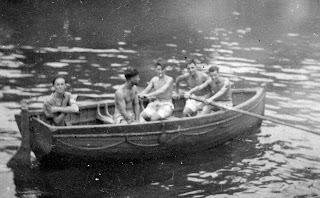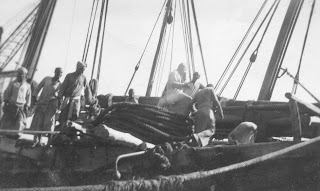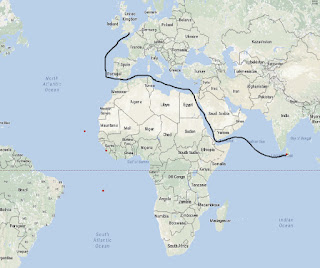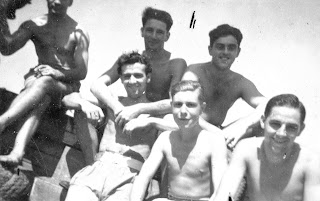We know that he served on HMS MFV 1558 and perhaps 1130.
 |
| MFV 1558 |

MFV 1558 sailed to the Indian Ocean as part of the build-up for the allied invasion of Malaya (now Malaysia) later in 1945. She was joined a few months later by HMS MFV 1130.
 |
| MFV 1130 |

On 20 July 1945, just before the invasion of Malaya, a Naval force left Trincomalee on the East coast of Ceylon. This force included five Algerine class minesweepers to clear a Japanese minefield near the Malayan coast. One of the minesweepers became disabled after hitting a mine and had to be sunk, and a second was destroyed by a Kamikazi, killing 20.
At the beginning of August 1945, the atomic bombs on Hiroshima and Nagasaki ended World War II in the Far East, just before a huge Allied force, including MFV 1158 and 1130, was due to invade Malaya.
Finally, the order came through in January 1946 that Henry’s crew would be returning to UK within a few weeks.
A set of photographs was taken at this time and were kept by Henry as a reminder of his time in Ceylon with his old shipmates.

Henry in RN uniform with unnamed colleagues, Colombo 1946.
Colombo Jan. 1946.
Back:
Arthur, Henry, Jack
Front:
Bramy, C.O., Ted

Boat Crew in Colombo Harbour January 1946.
Left to Right:
J.C., Arthur, Henry, Ted, Tim
 |
| Ceylonese Fishermen Landing their Catch, Colombo Jan. 1946 |
Henry’s cousin May Ayres, wrote in her book 'Shannocks in Wartime': I wrote regularly to…. Jimmy Bishop who we called ‘Chibbles’ who was in Ceylon. It's not known if Jimmy’s and Henry’s paths crossed or if they ever met during the war.
I returned to England via the Suez Canal and remember the Gilly Gilly man who was a sort of magician entertainer at Port Said.
 |
| Henry's route home from Ceylon in January 1946 |
I was demobbed in Portsmouth, given a suit, some cash and a railway ticket home. Some medals arrived in a cardboard box a few months later. That was the end of my War-time experiences.
The Royal Naval Patrol Service (RNPS) saw action in all theatres of World War II and lost 250 vessels, more than any other branch of the Royal Navy. As a result of the dangers of minesweeping and ant-submarine work, they were awarded a unique silver badge to be warn on the sleeve of those who served six months or more in the RNPS.
The RNPS Memorial in Belle Vue Park, Lowestoft, overlooking Sparrows Nest, commemorates the 2385 RNPS members who died during 1939 – 1946 and have no known grave, other than the sea.
 |
| RNPS Memorial |
Henry visited the RNPS museum once in the 1970’s where he signed to visitor’s book and collected a blue enamelled version of the silver RNPS badge. He did not join the RNPS Association.
Henry’s only known attempt to contact an old RNPS shipmate was in 1980 at Mevagissey, Cornwall, but contact was not maintained afterwards.
However, the visit to Mevagissey was not a disappointment as a famous wartime lifeboat “Guide of Dunkirk”, which took part in the Dunkirk evacuation of 1940, was in the harbour, as seen in Henry's photographs.


"Girl Guide": Ex RNLI Lifeboat "Guide of Dunkirk" at Mevagissey Harbour 1980
1946 was a busy year for Henry. He resumed his fishing career at Sheringham, enrolled in the local lifeboat crew and met his future wife. These three elements would be the focus of Henry’s future life.


